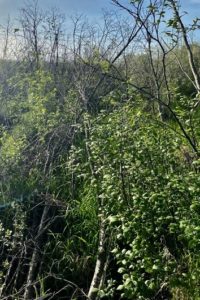 Many visitors to Woodland Dunes walk on the Cattail Trail boardwalk north of the nature center, and explore several different wetland habitats and eventually reach the marsh along the West Twin River. Because one can access these interesting and usually inaccessible habitats, Cattail is our most popular trail. The boardwalk meanders through shrub swamp, an alder thicket, sedge meadow, and cattail marsh. Each habitat has distinct plants and animals, and the boardwalk allows one to explore very wet areas but yet have dry feet. Some of the interesting animals encountered are mink, snapping turtles, yellow and common yellowthroat warblers, swamp sparrows, marsh wrens, ospreys and bald eagles, sora and Virginia rails, ducks, hundreds of red-winged blackbirds, and many more species.
Many visitors to Woodland Dunes walk on the Cattail Trail boardwalk north of the nature center, and explore several different wetland habitats and eventually reach the marsh along the West Twin River. Because one can access these interesting and usually inaccessible habitats, Cattail is our most popular trail. The boardwalk meanders through shrub swamp, an alder thicket, sedge meadow, and cattail marsh. Each habitat has distinct plants and animals, and the boardwalk allows one to explore very wet areas but yet have dry feet. Some of the interesting animals encountered are mink, snapping turtles, yellow and common yellowthroat warblers, swamp sparrows, marsh wrens, ospreys and bald eagles, sora and Virginia rails, ducks, hundreds of red-winged blackbirds, and many more species.What is striking now is that the alder thicket has obviously taken a beating in recent years. Speckled alder is an interesting tree, often found in the north but able to live here due to the cooling effect of Lake Michigan. Alders are not large trees, more like large shrubs. They grow in wet soils in clumps. They have many small openings called lenticels on their trunks, which allow the transfer of oxygen from the air to their roots, helping them cope with water in the soil. Their roots support nodules of bacteria which store nitrogen from air, providing nutrition to the alders and surrounding plants.
Because alders grow in wet soils, those soils are often soft and don’t support the trees well when the trunks become large. During high winds, alders often tip over. Also, alders like soils that are wet but not too wet. As a result of storms the last two summers, and recent high lake water levels which influence the lower West Twin, many of the alders have been either blown over or have died back from excessive wetness. The result is a landscape which has many dead, fallen small trees- a tangle of wood on the ground or water. Visitors are often alarmed at the mess now where a pleasant thicket of small trees had been.
Of course, what is happening is natural, not due to disease or predation. Wind and soils were not favorable to the alders recently, but now the water is starting to recede a bit. The cycle of renewal is beginning- young alder shoots are sprouting from the trunks of their fallen parents. In a few years there will be a new alder thicket. In the meantime, the tangle of fallen wood provides wonderful habitat for many birds. Woodpeckers seek insects in the dead trunks; afterward chickadees excavate nest holes there. Rails forage for food beneath the fallen wood, songbirds seek insects near the water under the cover of the branches, and life goes on.
Wetlands are dynamic habitats, undergoing many changes as the plants adapt to changing conditions over time. Fallen, dead trees in this case does not indicate a problem, just a transition. It will be interesting to see what happens as time goes on, but for now if you visit and see dead alders, know that it’s not a problem, just change in the process.
photo: dead and re-sprouting alders at Woodland Dunes by Jim Knickelbine
